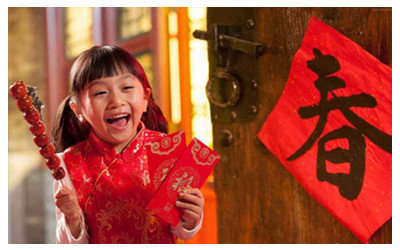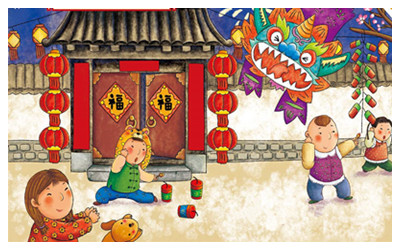
Chinese Spring Festival, Chinese Lunar New Year, is the longest and most important of the traditional Chinese holidays. It is often called the Chinese Lunar New Year. In the Gregorian calendar, Chinese New Year falls on different dates each year, a date between January 21 and February 20. In China, regional customs and traditions concerning the celebration of the Chinese New Year vary widely.
Legend of Chinese Spring Festival
According to tales and legends, the beginning of Chinese New Year started with the fight against a mythical beast called the Nian or "Year" in Chinese. Nian would come on the first day of New Year to devour livestock, crops, and even villagers, especially children. To protect themselves, the villagers would put food in front of their doors at the beginning of every year. It was believed that after the Nian ate the food they prepared, it wouldn’t attack any more people. One time, people saw that the Nian was scared away by a little child wearing red. The villagers then understood that the Nian was afraid of the color red. Hence, every time when the New Year was about to come, the villagers would hang red lanterns and red spring scrolls on windows and doors. People also used firecrackers to frighten away the Nian. From then on, the Nian never came to the village again. The Nian was eventually captured by Hongjun Laozu, an ancient Taoist monk. The Nian became Hongjun Laozu's mount.
Things to do during Spring Festival
Spring Festival, the Lunar New Year, commonly known as the Chinese New Year, generally refers to the New Year's Eve and the first day of the first lunar month. But in civil society, the Chinese New Year in the traditional sense is lasts from eighth day of the twelfth lunar month to the fifteenth of the first lunar month. And on New Year's Eve and the first day of the lunar month, it reaches the climax.
Laba Rice Porridge Festival
Laba Rice Porridge Festival falls on 8th Day of 12th Lunar Month. Chinese people start their preparations for the Chinese Spring Festival more than 20 days ahead. The 12th lunar month in Chinese is called la yue, so the eighth day of this lunar month is la yue chu ba, or laba. Three major customs on Laba are ancestor worship, eating Laba rice porridge and making Laba garlic. Especially, people will have Laba Rice Porridge on this day.
Welcoming Spring Festival
When Spring Festival is coming, people will pour out their money to buy presents, decoration, material, food, and clothing. New clothes are usually worn to signify a new year. It is also the tradition that every family thoroughly cleans the house to sweep away any ill-fortune in hopes to make way for good incoming luck. Windows and doors will be decorated with red color paper-cuts and couplets with popular themes of “happiness”, “wealth”, and “longevity”.
In many households where Buddhism or Taoism is prevalent, home altars and statues are cleaned thoroughly, and altars that were adorned with decorations from the previous year are also taken down and burned a week before the new year starts, and replaced with new decorations. Taoists will also "send gods", an example would be burning a paper effigy of the Kitchen God, the recorder of family functions.
Chinese New Year's Eve
On the Eve of Chinese New Year, supper is a feast with families. This is called "Reunion Dinner",also 团年饭(Tuan Nian Fan)in Chinese. Food will range from pigs, to ducks, to chicken and sweet delicacies. It traditionally includes fish, but not eaten completely, as the Chinese phrase "may there be fish every year" sounds the same as "may there be surpluses every year". The family will end the night with firecrackers.
Lunar New Years Day
Early the next morning, Usually, people will stay at home. But children will greet their parents by wishing them a healthy and happy new year, and receive money in red paper envelopes. It's sometimes distributed during the reunion dinner. These packets often contain money in certain numbers of money that reflect good luck and honorability, usually varying from a couple of dollars to several hundred. They are also known as Ya Sui Qian literally, the money used to suppress or put down the evil spirit. It is also common for married couples or the elderly to give red packets unmarried juniors.
 New Year Visits
New Year Visits The festival celebrations are marked by visits to kin, relatives and friends, a practice known as "new-year visits". Usually, the first day is a time when families visit the oldest and most senior members of their extended family, usually their parents, grandparents or great-grandparents. People will visit relatives and friends during the next several days. Gifts are usually brought when visiting friends or relatives at their homes. Common gifts include fruits, cakes, biscuits, chocolates, candies, or some other small gift. The tradition is a great way to reconcile forgetting all grudges, and sincerely wish peace and happiness for everyone.
Lantern Festival
When the Spring Festival just passes by, the Lantern Festival which is a traditional festival of Han Nationality falls on the 15th of the first month of the lunar calendar. January is the first month of the lunar calendar, the ancients called the night as "night", so the fifteenth day of the first lunar month is called Lantern Festival. The 15th of the first lunar month of the year in the first full moon night and it is also the start of the spring. People celebrate on the first full moon night and also celebrate New Year's continuation.


 New Year Visits
New Year Visits  Ask Questions ?
Ask Questions ?